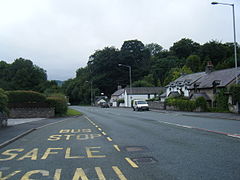Human settlement in Wales
| Cadole | |
|---|---|
 A494 at Cadole A494 at Cadole | |
 | |
| OS grid reference | SJ204628 |
| Community | |
| Principal area | |
| Preserved county | |
| Country | Wales |
| Sovereign state | United Kingdom |
| Post town | MOLD |
| Postcode district | CH7 |
| Dialling code | 01352 |
| Police | North Wales |
| Fire | North Wales |
| Ambulance | Welsh |
| UK Parliament | |
| Senedd Cymru – Welsh Parliament | |
| |
Cadole is a village in Flintshire, Wales. It lies west of Gwernymynydd and Mold (Yr Wyddgrug), south of Gwernaffield and to the east of the Clwydian Range, part of an Area of Outstanding Natural Beauty.
The name appears as Cat-hole, Cat Hole and Cathole on eighteenth century maps, and the village was still known by this name in living memory. The Place-Names of Flintshire states that the name was deliberately changed to its modern spelling following the gentrification of the area, so that the name could be derived from the Welsh place name elements 'Cae' (field) and 'Dôl' (meadow). One reason often given for this deliberate change was that English incomers found the name Cat-hole (or its English homographs) to be unseemly.
Landmarks

Just across the Denbighshire boundary from Cadole, and next to the A494, is Carreg Carn March Arthur (Welsh for 'the Stone of Arthur's Horse's Hoof'), a boundary marker consisting of a stone arch over an irregularly shaped rock. A plaque on the arch reads:
The stone underneath this Arch Carreg Carn March Arthur was Adjudged to be the Boundary of the Parish and Lordship of Mold in the county of Flint and of Llanverres in the County of Denbigh by the High Court of Exchequer at Westminster 10th November 1763
This monument features in a 1796 watercolour by John Ingleby.
References
- "Home". Gwernymynydd and Cadole community council. Retrieved 29 April 2023.
- Flintshire Conservation Areas, Flintshire County Council, retrieved 3 August 2009
- Owen, Hywel Wyn (2017). Place-names of Flintshire. Cardiff. pp. 37–38. ISBN 978-1786831118.
{{cite book}}: CS1 maint: location missing publisher (link) - ^ "Carreg Carn March Arthur". Land of Legends (en-GB). Retrieved 11 May 2023.
- John Ingleby (1796). The stone under this arch called Carreg Carn March Arthur.
